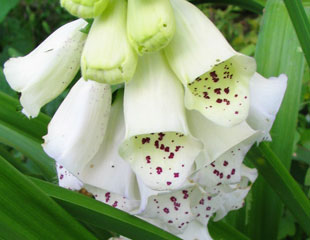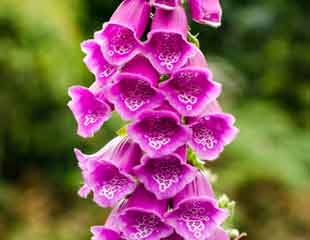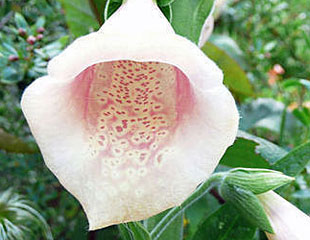


How to grow foxgloves
One advantage to growing Foxgloves is that they prefer semi shade and there are always some spots in the garden which lack sun. Digitalis, the Foxglove, is ideal and easy to grow in shady conditions. Foxgloves are fully hardy and will grow in almost any soil except the extremes of very wet or dry. Foxgloves are tall plants, D. purpurea (the common foxglove) grows up to 1-2m and is best suited to the back of a border.
Foxgloves look most effective grown in clumps. They are tall and imposing. Even though Foxgloves are tall, it is unnecessary to stake them an ideal easy plant. The common foxglove is often pink as in the image centre, pure white or white with purple specks, image left, but there are also some variations such as the Excelsior Hybrids (RHS Merit) which come in a variety of pastel shades and apricot illustrated above right 'Sutton's Apricot'. A bonus when growing Foxgloves is that they are attractive to bees and pollinators (more ideas for plants which are bee and butterfly friendly)
Foxgloves are easy to grow
Note: Foxgloves are poisonous. No part of the plant should be eaten and if you have children, you may wish to avoid planting digitalis. If you have concerns about a plant, there is a list of poisonous plants on the RHS website

Foxgloves are easy to grow and self seed extensively, providing you with a regular, free supply of plants. Foxgloves can be perennials, biennials and annuals. Common varieties grown and illustrated here are biennial, which means they set seed, produce the plant and foliage one year, and flower the next. Once you have Foxgloves in the garden, they will self seed so regularly as to produce a continuous set of new plants and flowers. Once established after the first year, the fact that Foxgloves are biennials isn't a problem.
Whilst Foxgloves do self seed extensively, they are not troublesome. The small plants are easy to pull up where they are not wanted, and equally easy to move around.
Ideal growing conditions for Digitalis are moist soil, humus rich on the acid soil which is to be expected from a Woodland plant. Fully hardy to between H5- H7.
Foxgloves are tenacious. I have even seen them growing out of stone walls in the smallest trough of poor soil.
When the plant has finished flowering, it will be full of seed. In the autumn, during September & October time, you can split the seed heads easily by crushing them, and shake out the seeds where you would prefer the new plants to grow. If you are not fussy where the plants grow, you can leave them and the wind will distribute the seed, dropping it around and dispersing seeds widely around your garden on the autumn winds.
Foxgloves used to be regarded as a cottage plant, but have revived in popularity recently, rightly so, as they look super in a mixed border. The pure white foxgloves look lovely in a mixed border as illustrated and the bees love them. There are so many good points to growing Foxgloves, easy, no maintenance, happy in semi shade and self seed themselves, definitely a green wheelbarrow plant.

Green Wheelbarrow indicates Foxgloves are easy to grow. They require no maintenance, no staking or feeding and will self seed around the garden to re appear next year, albeit often in a different place.
RHS plant trial of Foxgloves
In 2013-2015 RHS undertook a trial of Digitalis and some of the biennials awarded the AGM D. purpurea 'Pam's Choice' which is very distinctive white with purple/dark maroon throat. In the Camelot Series ' Camelot Cream, Lavender, Rose and White' and in the Dalmatian series, Dalmatian Creme, Peach, Purple, Rose and White' The RHS AGM is always a good indicator when selecting a plant the trial as assessing floriferousness, length of flowering, shade tolerance, longevity, decorative value, uniformity of seed strains, pest and disease resistance and overwintering ability. From this you can be confident that the RHS variety will be a good plant to grow.
